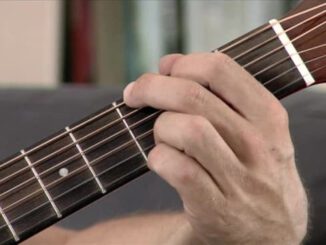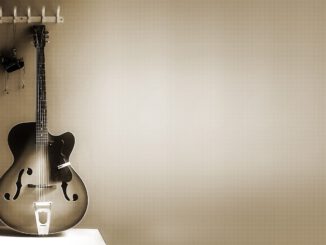 You don’t always have an electric tuner nearby, and well sometimes, especially when you’re jamming with others, it is more of a pain in the butt. Today I want to share with you an easy method you can follow to get your guitar in tune by ear with needing an electric tuner.
You don’t always have an electric tuner nearby, and well sometimes, especially when you’re jamming with others, it is more of a pain in the butt. Today I want to share with you an easy method you can follow to get your guitar in tune by ear with needing an electric tuner.
This is a skill you can learn very quickly and if you practice it each time you pick up your guitar you’ll be doing it in just a minute or two in no time at all.
Here is what you need to remember to tune your guitar by ear.
- The the 5th fret of a given string is the same note as the string below it in open position
- There is one exception to the above rule on the G string where it is the 4th fret
Let’s look at an example of a few strings.
The A String
If you want to check if the A string is in tune you can double check the pitch of the string with the 5th fret of the Low E string the string right above it. If you play the 6th string on the 5th fret it should sound the same as the open A string.
The B String
This is the exception I mentioned above. To check the tuning of the B string play the G string (one above it) on the 4th fret. The notes should both sound the same. If the B string seems to be off adjust it’s tuning with the tuning peg.
One Thing to Watch out For
Sometimes the string you’re tuning to (the one you’re playing on the 4th or 5th fret) is the string that is not in tune. You can double check this by comparing it to the string that you would use to tune the string in question.
Example: If you’re trying to tune the D string to the 5th fret of the A string but you have a sneaking suspicion that the A string isn’t in tune double check it by playing the 5th fret of the E string above the A.
If it’s the Low or High E strings that are in question you can always compare those two strings together. Strike the 6th or low E string and then the 1st or high E string. While there is an octave between them they should both sound the same.
Watch this brief video below where I explain this process in a bit more detail and tune my complete guitar using this method.
To master this I suggest you do it each time you pick up your guitar to practice. Before long it will be second nature to you.
Interested in learning more about playing guitar? Have you considered taking guitar lessons for beginners? You don’t have to sign up for private lessons you can study at home using DVDs, online videos and even ebooks.





At first I thought this was going to be something about training your ear. Then I thought “How sad is it that there needs to be a post about this.” Then I chilled out and remembered everyone starts somewhere. Good job providing info for newbies.
This is certainly a good place to start. However, you have to be careful when comparing an open string with a stopped string. When you stop a string, you bend it very slightly, altering its pitch (making it slightly sharper). Try this: on your top E, play the twelfth fret (i.e. the E an octave above), then play the octave harmonic. The stopped E will be slightly sharp. The closer the action, the less this will happen, but it’s bound to happen.
Yeah nice, and where do i get an A(440Hz) from?
I am confident a genius will figure it out 🙂
Hey Guys, all great comments. I don’t disagree what @ozzy is saying, you’re 100% right. How ever if you’re getting something from that particular lesson video then let’s face it that person is a beginner. They’re learning the notes on each string, they’re trying to figure out how the heck someone can make a G chord without muting the B string….
Worrying about the slight bend that occurs when you take your finger off the string for someone who has owned a guitar for a couple of weeks… just my opinion…. but pointless. Tell it to them in 3-6 months it will hold some meaning.
Everyone starts some where as @Waltz said.
Yup, with a little practice and a good ear. It gets easier and easier.